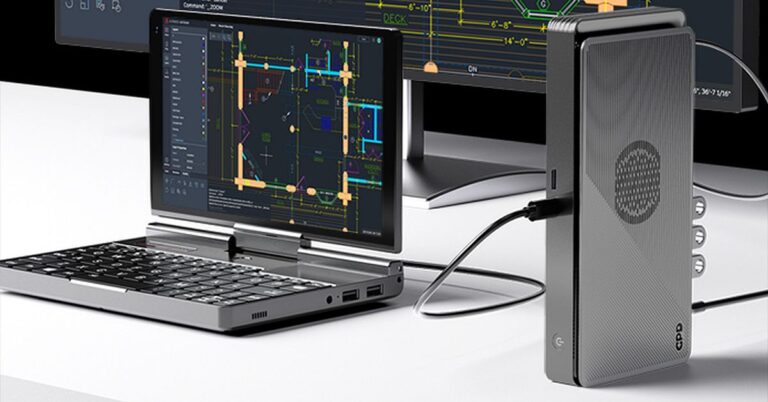
[ad_1]
GPD is crowdfunding a new compact external GPU docking station that can both boost the gaming capabilities of some laptops and handheld gaming PCs, and also help anchor them to a desk for mobile workers (via Liliputing).
The company is calling it the G1, and it includes an AMD Radeon RX 7600M XT chip with HDMI 2.1 plus two DisplayPort 1.4 video outputs, a USB 4 / Thunderbolt 4 connector to dock and charge, and something called Oculink (more on that in a bit).
GPD says it’s the “world’s smallest mobile graphics card expansion dock”, at just over an inch thick (29.8mm), around nine inches long (225mm) and four and a third (111mm) deep — all with an integrated power supply.
GPD isn’t quite the household name, but the Shenzhen, China-based company has been making a bit of a name for itself amongst PC gamers enamored by the recent handheld gaming boom. Currently, this market is held strongly by Valve’s Steam Deck, and there’s strong interest in Asus’ upcoming ROG Ally, but GPD’s been plugging away for years.
Those in the know are paying attention to other PC gaming handhelds like the Ayaneo 2S and GPD’s Win Max 2, and both companies will sell versions of them that feature an Oculink connector. The Steam Deck isn’t designed to support external graphics, so GPD is hoping the G1 graphics dock can be a big differentiator for its own devices — though it says you can use Thunderbolt 3, 4, or USB-4 if you don’t mind having less bandwidth.
The concept of a combined docking station and external graphics card (or eGPU) isn’t new. Alienware helped pioneer the idea with its “Amplifier” external chassis that housed both a high-profile desktop graphics card and USB hub to simply your setup, and eGPU.io is home to a buyer’s guide of the devices that followed. Most recently, Asus has pumped out painfully expensive but compact ROG XG graphics docks with Nvidia RTX 3080 and 3090s that go for up to $2,000.
Both the Alienware Amplifier and the ROG XGs have something in common: they eschew standardization by using different proprietary connectors that only work with their own matching laptops. Meanwhile, Framework is creating a new rear-slot ecosystem that supports add-in GPUs. So is GPD looking to adopt a real standard in comparison? Well, kind of!
The G1 is unusual in that it uses Oculink, which is a connector for PCI-Express that you would more typically see in enterprise server racks. If your laptop has an extra internal M.2 port, it can be outfitted to use this connector and hook up the G1 — potentially giving you reliable and better GPU performance (GPD claims up to 63Gbps bandwidth) compared to the more widely-supported USB4 and Thunderbolt-based (up to 40Gbps) eGPUs. Weak desktop computers could also get in on the action with an Oculink adapter card.
One problem with Oculink, besides not being available in most laptops or handhelds, is that it doesn’t carry the power and data you need to fully dock and charge a PC. So you’d likely not just plug in Oculink but also a USB-C connector to give your laptop or handheld up to 60W of power, and access the three USB-A ports and SD card reader.
Of course, the G1’s GPU and dock will need its own power, but luckily it doesn’t have a massive power adapter like some other eGPU solutions. Instead, the G1 integrates a 240W GaN power supply inside its own chassis.
GPD quotes impressive performance from its RX 7600M, claiming the mobile chip can beat a desktop RTX 3070 GPU in most games. GPD says it tested the 7600M paired with the same Ryzen 7 7840U you’d find in the newest gaming handhelds, versus the 3070 paired with a desktop Ryzen 5600X. That’s basically the same desktop my editor Sean Hollister runs, and he was wowed to see it.
If true, it could make for a remarkably powerful desktop you could fit into a tiny messenger bag — with one gaming handheld, one eGPU the size of a gaming handheld, and three cables (Oculink, USB-C, and AC), plus your mouse and keyboard.
The G1 is on Indiegogo, but the campaign has not yet begun as of this writing. GPD is seeking $20,000HKD to fund the project, but will get the money even if the goal isn’t met. Still, considering GPD has successfully funded almost every product it’s shipped in this manner, we expect the G1 to see the light of day. Mum’s the word on what the G1 will cost though.
[ad_2]